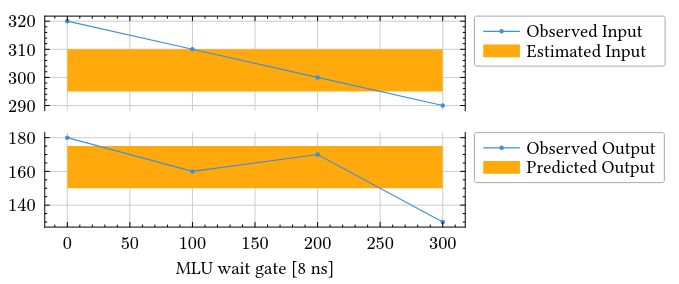I am trying to make a Figure with a “discontinuous” axis. Something like the following example (but vertical instead of horizontal):
I guess this is too niche, and there is no built-in way to do this, right?
So I am trying to do it with 2 diagrams on top of each other, but I am having some issues with a couple of things.
I can get something that starts looking in the correct direction:
#import "@preview/lilaq:0.4.0" as lq
#lq.diagram(
width: 8.9cm,
height: 2cm,
legend: (position: (100% + .5em, 0%)),
xaxis: (position: top, format-ticks: none),
lq.plot(
(0, 100, 200, 300),
(320, 310, 300, 290),
label: [Observed Input~~~],
),
lq.fill-between(
(0, 300),
(310, 310),
y2: (295, 295),
label: [Estimated Input],
z-index: 1,
),
)
#lq.diagram(
width: 8.9cm,
height: 2cm,
xaxis: (position: bottom),
xlabel: [MLU wait gate [8 ns]],
legend: (position: (100% + .5em, 0%)),
lq.plot(
(0, 100, 200, 300),
(180, 160, 170, 130),
label: [Observed Output],
),
lq.fill-between(
(0, 300),
(175, 175),
y2: (150, 150),
label: [Predicted Output],
z-index: 1,
),
)
which gives me
Issues I am having:
- I don’t know how to add these
/ /(or similar) between the gaps at the edges of the axis to give the idea of “discontinuous”. - I don’t know how to add a
ylabelthat is shared between both. If I try adding e.g.ylabel: [Counter rate [Hz]]to either of them, I can’t get it to not wrap around (and it shifts the individual diagram to the side, so they are not aligned any more).

